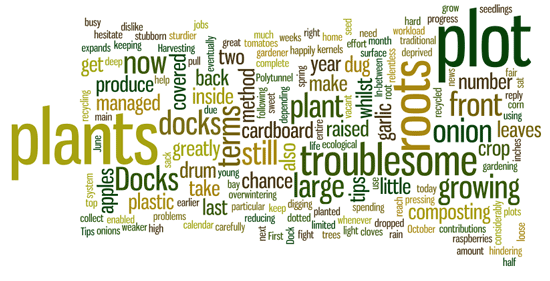The rain is hard relentless at the moment and has been for a while now, but there are pressing jobs that still need doing on the allotment plot before it gets too cold. October is still a busy month in the gardening calendar despite it being the end of the traditional growing season.
Harvesting
First things first, to collect some produce. Today I have managed to fill an old chicken food sack with apples from my trees, sat on top of the apples are a dozen sweet corn kernels and the last few raspberries from the vacant plot next to mine. Inside the Polytunnel there still remains a fair few Gardeners delight tomatoes and a few Tigrella which I will crop and take home with me after I’ve tidied up.
My onion and garlic crop
The great news on the onion front is that most of the overwintering onions I’ve started from seed are now almost 4 inches high after spending a few weeks in the Polytunnel.I have separated these young onion seedlings and put them in two raised beds at the front of the plot, these will now grow quite happily right through the winter until they are cropped in June of the following year. I’ve also managed to get some really large strong garlic cloves; these have also been planted at the front of the plot in a raised bed with fairly deep loose soil.
Tips on How to stop those troublesome plants
In-between finding bits of produce dotted around the plot and bagging it, the main task here today has been pulling out some of the more stubborn plants that are hindering the plots progress, Dock leaves are one particular plant that causes problems on my plot, they are large in number and limited in terms of what I can use them for as a resource other than composting the leaves earlier in the summer.
As much as I dislike digging, it is important to dig up the docks from their root whenever you get the chance to, once the roots have been carefully dug out they are then dropped in a plastic drum half full of water, where the Docks and other troublesome plants are broken down and recycled back into the growing system.
By keeping the plastic drum covered, the troublesome plants and roots inside are deprived of light whilst they are breaking down; this greatly hinders any chance of the plants growing back inside the container.This method of recycling sturdier unwanted plants seems to be more efficient than composting them down which can take two attempts depending on the thickness and the resilience of the roots.
The docks that are not dug up from their roots have been covered with thick sheets of cardboard, this will make the Docks considerably weaker when they eventually fight their way through the cardboard in spring, the weakening of the docks comes about due to the large amount of energy that the plant expands in trying to reach the surface, using this method last year enabled me to pull up the entire plant complete with roots with little effort whilst significantly reducing the number of Docks on the plot.
If you have any tips on how to keep troublesome plants at bay, please don’t hesitate to reply, any contributions in terms of tips and pointers will be greatly appreciated and will help to make the life of a gardener a little easier in terms of workload and ecological considerations.

